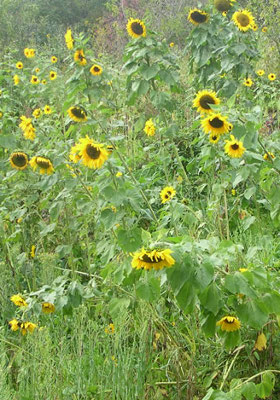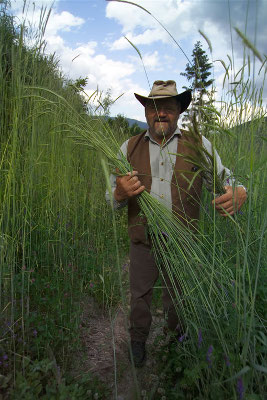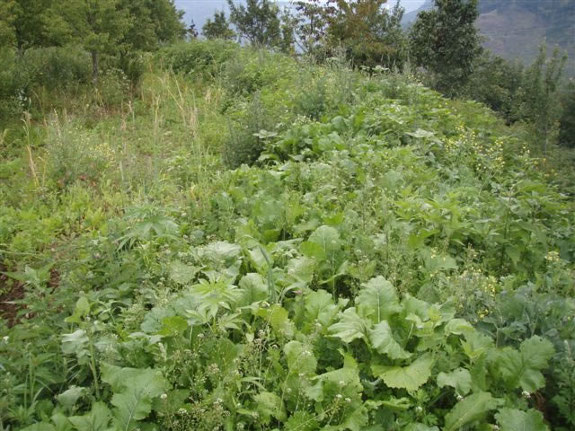
Green manure rejuvenates poor soil
 The most inspiring part of Sepp
Holzer's Permaculture
is the way Holzer takes poor soil that his neighbors think is only good
for tree plantations and turns it into a nearly self-sufficient, low
work farm that churns out food of all sorts. Although it's not
the most photogenic part of his homestead, green manure is the real
root of Holzer's success.
The most inspiring part of Sepp
Holzer's Permaculture
is the way Holzer takes poor soil that his neighbors think is only good
for tree plantations and turns it into a nearly self-sufficient, low
work farm that churns out food of all sorts. Although it's not
the most photogenic part of his homestead, green manure is the real
root of Holzer's success.
As Holzer brings new
areas into production, he seeds a wide variety of plants and then
leaves the plot alone for two or three years. The mixture of
plants serves a variety of purposes ecologically, and also builds soil
as the green manure plants die back each fall, reseed, and grow again
the next spring. (I'd actually call his plants cover crops, not green manure, since he
doesn't till them into the ground, but I'm sticking to the terminology
in his book.)
Holzer plants sunflowers
and hemp to feed the birds and mixes in a wide variety of flowers for
pollinators: cornflowers,
yarrow, calendula, golden marguerites, scented mayweed, spreading
bellflowers, and comfrey. Next, he adds soil builders: peas,
beans, clover, lupin,  cabbages, oilseed rape,
turnips, sunflowers, buckwheat, and sweet clover to improve the soil
(and hold it in place after his excavator moves the earth
around). The diverse polyculture that results is what Holzer
calls green manure.
cabbages, oilseed rape,
turnips, sunflowers, buckwheat, and sweet clover to improve the soil
(and hold it in place after his excavator moves the earth
around). The diverse polyculture that results is what Holzer
calls green manure.
Later, once the soil is
in production in ways I'll explain in later posts, other plants join
the mix. Holzer grows a variety of grains (rye, wild rye,
sorghum, millet, and perennial Siberian grain), legumes (a long list of
which can be found in his book), and root crops (turnips, radishes,
salisify, black salsify, and Jerusalem artichokes) to feed his cattle
and pigs over the winter with no work on his part.
The takeaway message for
the average homesteader is --- soil building takes time, so start
now. Several of you have recently bought acreages with pasture in
various states of disrepair, and many of you won't even be moving onto
the land within the next year. Seeding a diverse array of cover
crops is a perfect way to improve your farm during that one afternoon
you'll be visiting, giving you a multiple year jumpstart when you're
actually on the land.
| This post is part of our Sepp Holzer's Permaculture lunchtime series.
Read all of the entries: |
Want more in-depth information? Browse through our books.
Or explore more posts by date or by subject.
About us: Anna Hess and Mark Hamilton spent over a decade living self-sufficiently in the mountains of Virginia before moving north to start over from scratch in the foothills of Ohio. They've experimented with permaculture, no-till gardening, trailersteading, home-based microbusinesses and much more, writing about their adventures in both blogs and books.
Want to be notified when new comments are posted on this page? Click on the RSS button after you add a comment to subscribe to the comment feed, or simply check the box beside "email replies to me" while writing your comment.


We're planning to spend a week at our land again in late April. What would you recommend I seed in our pasture to jump-start our renovation?
The area to the left is the grownup part, and to the right is the lawn. My pseudo-plan to use the lawn part for the vegetable garden and the grownup area for animals. I would love to be able to do something now while we're still in the planning stage!
~ Mitsy
Mitsy --- Your pasture actually looks pretty lush to me! It's hard to give you suggestions because pasture is so animal- and soil-specific. I'd actually recommend you read All Flesh is Grass (or stay tuned until I finish it and write a lunchtime series) to get some ideas of classic pasture mixtures.
One basic suggestion would be to add legumes, although late April isn't a good time to do that. In general, you'll need to have an idea of whether your animals are going to be grazing short grass (like chickens) or tall grass (like cows) since different clovers thrive in each system (white likes it short, red likes it tall.)
That said, if you're going to do pigs, tubers are the way to go, and April would be a fine time to put in some Jerusalem artichokes!
Yippee, something new to research! I'm very much looking forward to that lunchtime series (and maybe I'll order that book, too). It's good to know that we have a good pasture base on which to start - and I'm trying to focus on non-picky livestock anyway. Thanks again for your valuable insight!
~ Mitsy
I'm always happy to give advice, just so long as you keep in mind that the pasturing information is nearly all book learning.
You'll see a bit more about Jerusalem artichokes in this week's lunchtime series....
I'm excited to experiment. You give me nitty gritty details, and I'll put them into action. And then we can (hopefully) both enjoy yummy pork and possibly other delicious homegrown meats.
~ Mitsy
Emily --- That's one of the unfortunate side effects of his obsession with heavy machinery --- he always seems to start with bare soil because it's been churned up by the excavator. Over-seeding is something I want to learn more about, though!
Mitsy --- With a subject line like that.... I'm excited to be joining you in a pork partnership!
I'm excited to be joining you in a pork partnership!
Pigs also do surprisingly well on pasture alone, with the right genetics and management pigs can live on pasture with no other inputs! With the cost of feed I think that this is the way to go. I am thinking about having a dairy cow (or maybe sheep) in addition to my pigs to supply my dairy needs, giving the surplus to the pigs, to give them a boost in calories, and lysine.